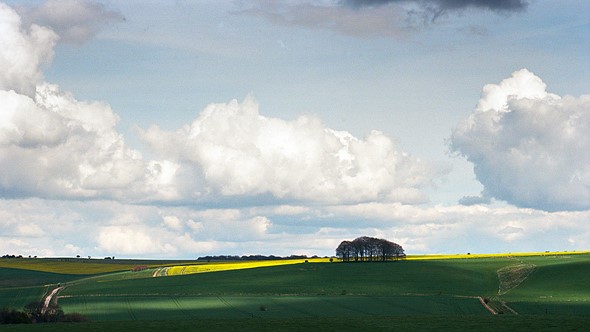| Photograph of the Olympus iS-300 by Matthew Bigwood |
When we think of bridge cameras nowadays, we typically think of DSLR-style compact cameras with massive zoom ranges and heavily cropped image sensors. But bridge cameras were around before the days of digital and Matthew Bigwoodwriting for 35mmchas shared his thoughts on using the Olympus iS-300 with a roll of Kodak Ektar 100 spooled up inside.
Bigwood came across the fixed-lens 35mm single lens reflex camera during one of his usual trips to the local charity shops. This particular model, the Olympus iS-300, was the seventh-generation device released in 1999, eight years after the original iS-1000, and three years before the final iS series camera, the iS-500. The iS-300 offered a fixed, motorized 28–110mm lens with a variable F4.5 through F5.6 aperture. Despite the relatively slow aperture, Bigwood says the ‘image [was] surprisingly bright, brighter than some 35mm SLR cameras [he’s] used from the same era. ‘
 |
| Avebury Stone Circle was named a UNESCO World Heritage Site. Photo by Matthew Bigwood. |
As Bigwood notes, Olympus opted not to call these cameras SLRs, but instead ZLRs, an initialize for ‘zoom lens reflex.’ Behind the fixed lens is a vertical focal plane shutter with speeds ranging from 1 / 2000th of a second to four seconds. A twin-tube Xenon flash module served as the onboard lighting and the camera is powered by a pair of CR123 batteries.
To put the camera to the test, Bigwood loaded a roll of Ektar 100 and took the camera out to Avebury Stone Circle, a neolithic henge monument consisting of three circles, located in Wiltshire, England. Bigwood says the camera’s autofocus proved ‘reasonably fast and accurate, though noisy.’ But, as noisy as the autofocus was, Bigwood says it was ‘the shutter and subsequent motorized film advance’ that proved to be the noisiest elements of the experience.
 |
| A view of the Wiltshire landscape, shot at the longest focal length of 110mm. Caption and photo by Matthew Bigwood. |
As for image quality, Bigwood says the lens ‘seems very sharp for a 20+ year-old design with a wide range of focal lengths.’ In his conclusion, Bigwood posits the iS-300 ‘was one of the “last rolls of the dice” for a high-end 35mm consumer camera before the relentless march of digital.’ We all know how that turned out, but it goes to show just how capable film cameras, even relatively compact ones, were becoming as digital started its takeover of the photography world.
Head on over to 35mmc to read Bigwood’s entire write up with more images and additional details about his experience with the Olympus iS-300:
About Film Fridays: We’ve launched an analog forum and in a continuing effort to promote the fun of the medium, we’ll be sharing film-related content on Fridays, including articles from our friends at 35mmc and KosmoFoto.













